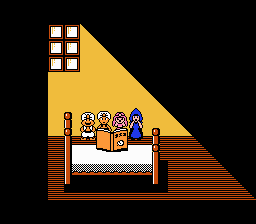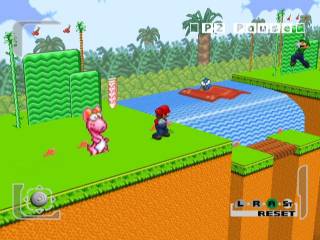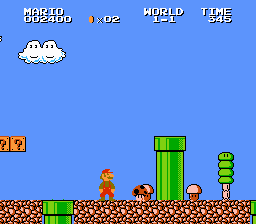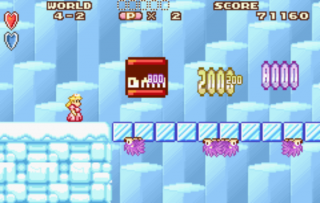In Defense of Super Mario Bros. 2
By gamer_152 25 Comments
For a long time I’ve felt that Super Mario Bros. 2 is a little underappreciated. I don’t often hear people say that they actively dislike the game, and it was very popular at its release, but many don’t count it as a real Mario game, or just see it as much less notable than other classic Mario titles. If you’re reading this, you probably know about the nature of Mario 2’s development, and how it has led many to not consider it a proper Mario game, but the retelling of this development story is often somewhat butchered.

The bit that a lot of people know is that the original Super Mario Bros. 2 was released in Japan, but not considered suitable for a western audience due to being significantly harder than its predecessor. Instead, Nintendo reskinned a successful Japanese game by the name of Yume Kōjō: Doki Doki Panic (often shorted to just “Doki Doki Panic” and roughly translating as “Dream Factory: Heart-Pounding Panic”) with Mario characters, and released that in the west as Super Mario Bros. 2. When Nintendo eventually released Super Mario All-Stars for the SNES, a version of the Japanese Mario 2 finally made it over on the cartridge under the name “Super Mario Bros.: The Lost Levels”. From this many have concluded that what we know as Super Mario Bros. 2 actually has very little to do with the Mario franchise, but I don’t think this is the case.
The Real Development Story
See, Mario 2 may be a modification of Doki Doki Panic, but Doki Doki Panic has its roots in Mario. The game’s development started with Kensuke Tanabe of SRD (Systems Research & Development), a company that had developed a number of early titles for Nintendo. Tanabe created a prototype for a Mario-like platformer, but where the focus was on making your way from the bottom to the top of the screen, instead of from the left to the right, and where picking up, placing, and stacking items and other players could help players climb higher. Tanabe failed to find a viable way to build his concepts into a workable product, but he was later hired by Nintendo, and both he and Shigeru Miyamoto were tasked with making a game out of Tanabe’s ideas.

The two struggled with the project, largely because it was difficult to make the game fun without two players, but making it a two player game with the limited technical power of the NES wasn’t possible. With this in mind, Miyamoto decided that they should rework what they had under a more Marioesque design, and build the game as a left-to-right scrolling platformer. From here Doki Doki Panic began to take shape. Tanabe acted as director, Miyamoto was producer, Mario composer Koji Kondo created the soundtrack, and the game was collectively created by the Mario development team. This is why Doki Doki includes Mario jump sound effects, POW Blocks, Starmen, Coins, and Warp Zones. Reportedly, Miyamoto actually spent more time developing Doki Doki Panic than he did developing the Japanese Super Mario Bros. 2. As you may know, Doki Doki was also a licensed game, and holds a particularly odd position in gaming history, being one of the few licensed games not based around a movie, comic, television show, or even book. It was instead created for the Japanese television network Fuji, to promote their Yume Kōjō media and technology expo. The four characters seen in Doki Doki were the mascots of the event.
When it came to turning this game into Super Mario Bros. 2, Nintendo did more than just reskin the characters. Obviously, they were far from overhauling the game in any big way, but they made noticeable changes to graphics, sound, and gameplay. Maybe the biggest difference between Doki Doki Panic and Mario 2 is that while Doki Doki uses health in a fairly conventional way, Mario 2 adapts one of the original Super Mario Bros.’ central mechanics, and makes it so that when you drop to one point of health, you shrink in size, and if you manage to gain health back, your size increases again. Surprisingly, the modifications to Doki Doki also included removing some oddly racist imagery from the game. Really.
Closer Than You Think
Despite often being thought of as somewhat unMario, we can see that Mario 2 originally came from a prototype that was using elements of Mario, was then overhauled with Mario in mind by the team who created Mario, and was later tweaked again for release as a Mario game. I think it shows. There are obviously plenty of places where the game breaks from the traditions of the franchise, but with the familiar platforming, the vibrant and slightly cartoonish world, the open blue background, the grass under feet, the surreal enemies and items, the chipper soundtrack, and the Mario sound effects, it’s really not a million miles from the other Super Mario Bros. games. Super Mario Advance’s version of Mario 2 pushes the game even further towards the conventions of the series, having your number of lives displayed on the screen at all times, and adding a scoring system which ticks up as you dispose of enemies. It also borrows the Dragon Coins mechanic from Super Mario World in the form of Ace Coins, and features additional voice acting for the characters.

While Nintendo may have left a lot of the pieces of Mario 2 where they lay, we can also see that the game did have an influence on later Mario titles, and received a fair degree of acceptance by Nintendo as part of the franchise as a whole. Mario 2 played a major part in defining how the characters in subsequent 2D Mario games looked, and brought us that flutter jump that became the famous feature of Luigi. The Shy Guys and Bob-Ombs became a part of the enemy roster in later Mario adventures, and recurring boss Birdo joined the series cast as well. Lastly, Super Smash Bros. Melee’s inclusion of a Mario 2 stage should give some indication that Nintendo consider it a pretty important part of the Mario series. However, despite the game having a whole history connected to the rest of the franchise, I feel like maybe there doesn’t have to be this huge justification for Mario 2 as a proper Mario game anyway.
Suppose Mario 2 really was a game completely unconnected with Mario, apart from the fact that they’d spliced Mario character sprites into it. I know many think it sounds cheap that someone could do that and call it a proper Mario game, but why wouldn’t it be? If we found out tomorrow that Super Mario Bros. 3 had actually been an overhaul of another game, would it be not a Mario game? I mean to some degree the graphics and sounds that make up the Mario universe are just wrappers for whatever gameplay they’re put around. Mario 2 may break from a lot of the conventions of the other Mario platformers, but there are other franchises that make major changes in a single iteration, and we don’t consider the games in which those changes happen to be any less part of the series. We consider Mario Tennis a Mario game, even though its gameplay has basically nothing to do with other Mario games, and the only major link is in its graphics, sound, and general tone of its gameplay. I’m not entirely willing to come out and say that Super Mario Bros. 2 should be thought of the exact same way we think of any other Mario game, but at the same time I also feel like the criteria by which we’ve tried to classify it as a non-Mario game might be a bit arbitrary.
The Right Choice
But okay, while I believe that Mario 2 is more of a Mario game at heart than people give it credit for, the deviations it takes from the standard Mario formula are obvious, so let’s talk about them. I am a strong believer that it was a good thing Doki Doki was reworked into Mario 2, and that we are better off for it. Firstly, while I’ve seen many lament that we didn’t immediately get the Japanese Mario 2 in the west, and instead got the Doki Doki overhaul, I think there’s a good chance that Nintendo made the right choice when it came to the franchise’s wellbeing.

The original Super Mario Bros. obviously had a much wider audience than the average game, and I think it might have owed a fair bit of that to its welcoming difficulty and general friendly tone. These were not traits that the Japanese Mario 2 carried, at least not to the same extent. It’s not as if the game is masochistic to play, but in places Japan’s Mario sequel isn’t just harder, but seems a little unfair. It has trick mushrooms that hurt you, gusts of wind that blow you off of platforms, invisible blocks that cut off your jumps, a Bowser that turns out to not be the actual Bowser, and a Warp Zone that returns you to World 1. Even the Lost Levels version of the game underwent some of its own alterations to make it easier to play than its Japanese counterpart. It was probably for the best that Nintendo didn’t jeopardise the series by releasing the eastern Mario 2 in the west. However, I think the lack of acceptance of Mario 2 is to do with much more than the Doki Doki Panic situation.
The gaming community at large don’t know the Doki Doki Panic story, but what they do know is the pool of items, enemies, locations, and other concepts that Nintendo repeatedly pull from for the Mario games. Some components from Mario 2 did carry forward into later games, but it’s never felt like the rest of the Mario franchise drew as much influence from Mario 2 as they did from Mario 1, 3, and World. Mario 2 deviated from the pattern of the series, and Nintendo quickly decided to return to it, largely forgetting the iconic parts of Mario 2. Despite that being the case, I think the game not falling in line with the norms of the series is the best bit about it.

If you look back at Japan’s second Super Mario Bros., it played itself incredibly close to the original. Not only was the gameplay very similar, but sprites and sounds were pulled from the first Mario game in huge clumps to piece it together. On a larger scale, the Mario series has also been very iterative, for better or for worse, and yet the Doki Doki modification represents a break from the basic Mario framework that we would never have gotten otherwise. It has multiple characters each with their own abilities, a crazy new world, items, and enemies, those grab-and-throw mechanics, and more vertical platforming, all within the context of a Mario title. I also genuinely believe that Peach’s appearance in Mario 2 is one of the best examples of a character in a game stepping out of their traditional role. Of course Nintendo deserve little credit for it, Peach is only really a playable character in Mario 2 because Nintendo needed to reskin a Doki Doki Panic character that wore robes and had a very floaty jump, but here’s a Mario game you can play through from beginning to end using the character that is otherwise the most recognisably disempowered woman in gaming, just as you can with all the other characters. It’s pretty great.
As a bit of a side note, I’d also like to mention that the Super Mario Advance version is a great game in its own right. The graphical capabilities of the Gameboy Advance mean that it’s able to present a Mario 2 that’s far more visually fleshed out and colourful than what we saw on the NES, but still keep to a rather humble sprite-based world. Seeing the two versions of the game side-by-side, you also get a sense for just how thoroughly Nintendo redesigned the levels.
A Sub-Con Summary
Ultimately, it may not have started life as a Mario game, but I think Super Mario Bros. 2 deserves greater acceptance as part of the Mario series. And while it may not be quite as classic as a lot of other Mario games, its unique development circumstances led to a game that stands out as an original but none the less enjoyable title in the midst of the other rather similar Mario experiences. Thanks for reading.
Sources
IGN: The History of Super Mario Bros.